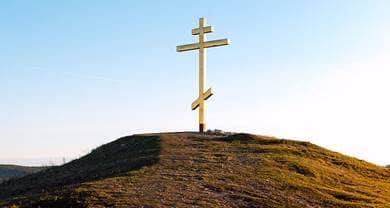- Trending:
- Pope Leo Xiv
- |
- Israel
- |
- Trump
- |
- Social Justice
- |
- Peace
- |
- Love

RELIGION LIBRARY
Eastern Orthodoxy
Worship and Devotion in Daily Life
Prayers at regular intervals throughout the day are an integral part of daily life in Eastern Orthodox tradition. Daily prayer is a communal matter, and is conducted in the churches and the monasteries. Private prayer in the home combines liturgy with spontaneous personal prayer.
Daily worship in Eastern Orthodoxy is conducted in a twenty-four-hour cycle, reflecting Christianity's Jewish roots. The liturgical day begins at sundown, and at that time, the churches and monasteries hold a service of prayer called Vespers. A prayer service called Compline occurs after the evening meal and before bed. A service called the Midnight Office is held at midnight, usually only in the monasteries. The service of Matins is held just before sunrise. There are four other prayer services, called Hours. The First Hour is often said immediately following Vespers. Many churches say the Third and Sixth Hours during the Proskomedia portion of the Divine Liturgy, and the Ninth just before Vespers. Orthodox tradition does not list the Divine Liturgy in the daily cycle of prayers because it is believed to occur outside of normal time. The daily prayers occur inside normal time (chronos), and serve to sanctify it while bringing the faithful into eternity (kairos).
During the prayer services, the faithful repeat a number of litanies, or prayers of petition, for both the living and the dead. They also read the Psalms, which are arranged in a special book called a Psalter. If all nine services are held each day, the entire Book of Psalms is read in a week. The choir also chants short hymns. A priest cannot celebrate alone, but must have at least one other person present. As a result, in some parishes the prayer services are only held on the weekends and at major feasts.
Many Orthodox faithful also maintain house shrines and pray in the home in the morning and at night. The house shrine consists of an icon placed in a corner or on a shelf. Family members will light a lamp, offer incense, and pray. There are manuals that instruct the faithful in how to pray at home, so that even house prayers are liturgical. Orthodox tradition teaches that when everyone says the same prayers, regardless of their physical proximity to each other, they still pray as a community. Prayers in the home are also spontaneous and personal. While the designation of particular saints is an official matter, every Christian is viewed as a saint, by virtue of participation in the community, called the body of Christ. Many Orthodox Christians will pray for help and intercession from deceased family members, or other deceased people dearly loved by them or their families.
In his First Letter to the Thessalonians, the apostle Paul instructed the faithful to "pray continually" (1 Thessalonians 5:17), and Eastern Orthodox tradition has taken this admonition to heart. In the monasteries, some have practiced hesychasm under the supervision of an adept or a guide. Hesychasts have long used the Jesus Prayer in their discipline, which uses the words, "Lord Jesus Christ, Son of God, have mercy on me, a sinner." The Jesus Prayer has recently become popular with lay Christians as well. The purpose of the Jesus Prayer is to engender a state of continuous prayer. The idea is to repeat the prayer so often that it begins to repeat itself in the heart of the believer. If this state is achieved, then the Christian prays without ceasing, not even interrupted by sleep. Achieving this state is not easy, and depends on physical, emotion, and mental discipline, as well as spiritual perseverance. But for the ordinary Christian, the Jesus Prayer is portable, inspiring, and comforting, easily said while walking to the commuter train, shopping for the week's groceries, at times when other words are hard to find, or in times of anxiety when the mind searches for calm.
Study Questions:
1. How is prayer incorporated into daily life?
2. Describe the relationship between time and worship. How can time transform physical space?
3. What is the Jesus Prayer? When is it used?










